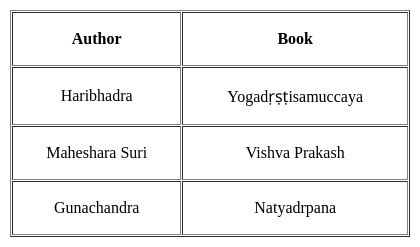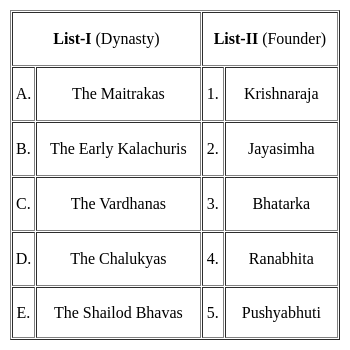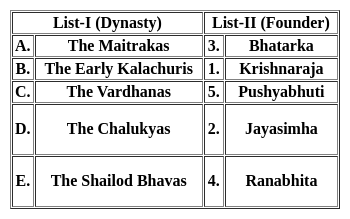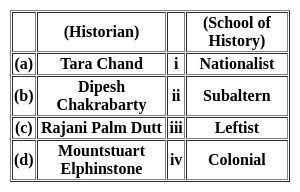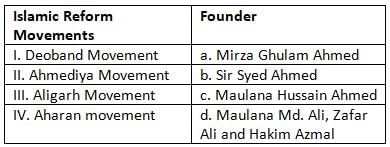APSET Paper 2 Mock Test - 10 (History) - AP TET MCQ
30 Questions MCQ Test APSET Mock Test Series 2026 - APSET Paper 2 Mock Test - 10 (History)
In which among the following King's reign Persian traveler Abdur Razzaq came to India?
Which of the following pairs is/are correctly matched?
- Gandhara school: Grey sandstone/bluish-grey sandstone
- Mathura school: Spotted red sandstone
- Amravati school: White Marbles
Select the correct answer from the codes given below:
Which among the following incident took place during the viceroyship of Lord Canning?
- Government of India Act of 1858 passed
- Indigo revolt
- Indian Council Act of 1861 passed
- Famine in the North-Western provinces
Choose the correct option from the codes given below :
Which among the following was the primary cause of 1857 revolt?
Match List I with List II, and select the correct answer by using the codes given below the lists:
List - I
I. Lingayats
II. Alwar
III. Nayanar
IV. Advaita
List - II
a. Andal
b. Karaikkal Ammaiyar
c. Basava
d. Shankara
Codes:
Match the following and choose the correct option:
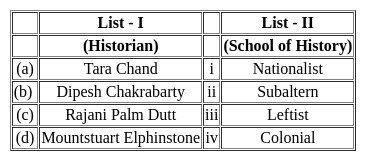
With reference to Ryotwari Settlement, consider the following statements:
1) The rent was paid directly by the peasants to the Government.
2) The Government gave Pattas to the Ryots.
3) The lands were surveyed and assessed before being taxed.
Which of the statements given above is/are correct?
Which of the following statements is/are correct regarding Prarthana Samaj?
1. It didn't reject the Vedas and emphasized Bhakti towards God.
2. They were against the caste system and the practice of untouchability.
3. It opposed the idea of Widow remarriage but propagated Women's education.
In which of the following areas are the beginning of settled life associated with a Chalcolithic rather than a Neolithic phase?
1. Rajasthan
2. Malwa
3. Northern Deccan
4. Gujarat
Select the correct answer using the codes given below
With reference to freedom struggle of India, consider the following statements of Swadeshi Movement:
1. In Rawalpindi (Punjab), the arsenal and railway workers went on strike led by Lala Lajpat Rai and Ajit Singh.
2. Subramania Siva and Chidambaram Pillai led strikes in Tuticorin and Tirunelveli in a foreign-owned cotton mill.
Which of the above statements is/are not correct?Which of the following statements are correct about the Sakyas clan?
- It was situated near the border of Nepal.
- Mahatma Buddha’s mother belonged to this clan.
- It had a unitary constitution.
- The capital of Sakya was Kapilavastu.
Select the correct option from the codes given below:
By the Charter Act of 1793, the trade monopoly of the Company was extended to how many years?
Which among the following recommendations of the Aitchison committee are correct?
- Maximum age of entry in civil service was fixed at 23
- Simultaneous examination in England and India should be stopped
- Two-tier classification of Civil Service would be replaced by a three-tier classification
- Statutory Civil Service should be abolished
Choose the correct option from the codes given below:
Consider the following statements regarding Round table Conferences:
- The 1st Round Table Conference was chaired by the British Prime Minister, Ramsay MacDonald.
- In the 2nd Conference, Atlee announced the formation of North-West Frontier Province.
- Tej Bahadur Sapru represented the Liberals in the 2nd Conference.
Which of the statements given above is/are not correct?
Below given are two statements, one is labelled as Assertion (A) and the other as Reason (R):
Assertion(A): Raja Todar Mal was made the Revenue Minister of Akbar and was known as ‘Mir-i-Tuzak’.
Reason(R): Todar Mal introduced ‘Bandobast’, a revenue assessment system that classified land into four categories.
Select the correct answer using the codes given below:
Consider the following statements with reference to the Doctrine of Lapse.
1. The doctrine of lapse in India was solely an invention of Lord Dalhousie.
2. According to the doctrine, any princely state would automatically be annexed if the ruler died without a male heir.
Choose the incorrect statements.
With reference to Deccan Riots consider the following statements:
1. Here money lenders were mostly outsiders - Marwaris or Gujaratis.
2. Modern Nationalist Intelligentsia of Maharashtra opposed the peasants' cause due to the violence.
Which of the above statements is/are correct?
The Indian Universities Act was passed in which year?
Which is that source which gives a lie to the tradition of a fratricidal war of Asoka?
Consider the following statements.
I. Mathura school of Buddhist art was developed by the Kushan dynasty.
II. Gandhara school of Art was developed by Sunga dynasty.
III. Amravati School was developed by the Satvahana dynasty.
Choose the incorrect statement.
The capital of India was transferred from Calcutta to Delhi in which year?
|
60 tests
|



